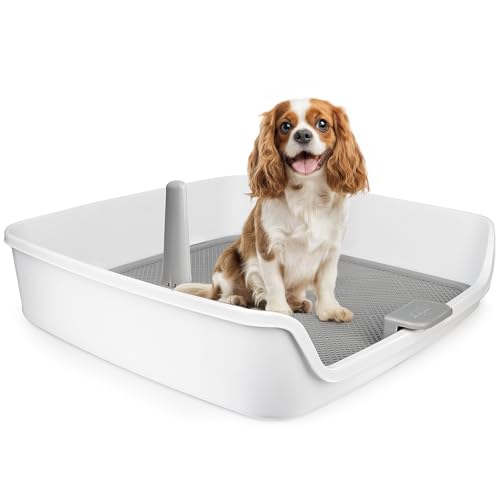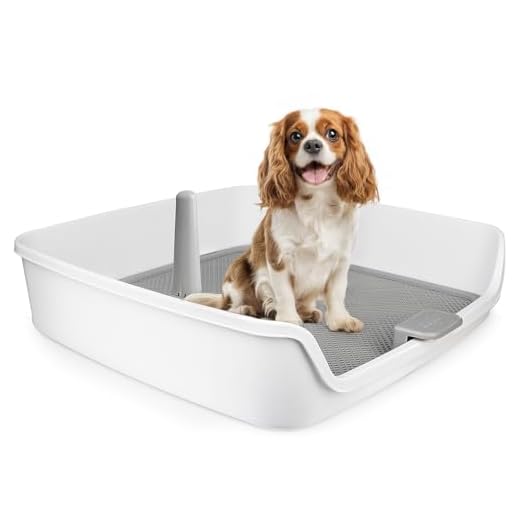




Set a consistent schedule for bathroom breaks. This routine helps your furry companion understand when it’s time to relieve themselves. Take them out first thing in the morning, after meals, and before bedtime. Observing their signals can also guide you; pacing, whining, or sniffing around often indicate they need to go outside.
Utilise positive reinforcement to encourage desired behaviour. When your companion successfully goes outdoors, reward them with praise or a treat. This creates a positive association with the act and motivates them to repeat it. Be patient; older pets may take longer to adjust to new routines.
Consider their physical needs. Older animals may have mobility issues or health conditions that affect their ability to hold their bladder. Ensure easy access to the outdoors, whether that means using a doggy door or making frequent trips outside. If mobility is a concern, you might explore options like pads designed for indoor use.
Stay observant of any health changes. If you notice accidents happening more frequently, or if your pet seems uncomfortable, it may be time to consult a vet. Infections, diabetes, or other medical issues could be influencing bathroom habits. Addressing these underlying issues is key to helping your companion thrive.
Creating a Comfortable Routine
Establish a consistent schedule for bathroom breaks. This is key for older canines, as they thrive on predictability. Take your furry friend outside at the same times each day, such as after meals, first thing in the morning, and before bedtime. This routine helps them understand when to expect outings.
Watch for Signs
Be attentive to your companion’s cues. They may circle, sniff, or whine when they need to relieve themselves. Learning to recognise these signals can prevent accidents indoors. If you notice these behaviours, promptly guide them outside.
Reward System
Positive reinforcement is incredibly effective. When your four-legged pal successfully goes outside, offer treats or praise immediately. This creates a positive association with the outdoor bathroom break. Over time, they will connect the dots and seek to please you by going outside.
For those with dietary concerns, ensuring your pet gets the right nutrition is vital. For instance, consider this best food to feed dogs with kidney failure if your companion faces health issues. A balanced diet can impact their overall well-being and bathroom habits.
Patience is required throughout this process. Older canines may take longer to adapt, but with consistency and care, you’ll achieve success together.
Assessing Your Senior Companion’s Health Before Training
Check with a veterinarian to rule out any underlying health issues. Conditions like arthritis or urinary tract infections can affect behaviour. A thorough examination provides insight into your furry friend’s physical state, allowing for a tailored approach that accommodates their needs.
Monitor Behavioural Changes
Pay attention to any shifts in routine or habits. If your loyal friend suddenly begins having accidents, it can signal discomfort or confusion. Take note of any signs of distress, such as pacing or whining, which may indicate an urgent need for assistance.
Consider Dietary Needs
Diet plays a significant role in your canine’s well-being. Ensure that they are receiving the appropriate nutrition to support their health. Sometimes, a simple change in diet can improve digestion and reduce the frequency of accidents indoors. Always consult with your vet for recommendations tailored to your companion’s age and health conditions.
Finally, be patient and compassionate. Every friend is unique, and understanding their specific needs will make the transition smoother for both of you.
Choosing the Right Training Area for Potty Breaks
Pick a consistent spot for bathroom breaks; familiarity helps your furry friend understand where to relieve themselves. Look for a location that is quiet and free from distractions, allowing your pet to focus on the task at hand.
Factors to Consider
- Accessibility: Choose an area that is easy to reach, especially if your companion has mobility issues. Avoid steep hills or uneven ground.
- Safety: Ensure the space is secure, away from busy roads or areas with heavy foot traffic. This reduces anxiety for both of you.
- Surface: Grass or dirt is preferable. Avoid hard surfaces like concrete, as they may be uncomfortable for an older animal.
- Weather Protection: If possible, select a location that provides some shelter from the elements. Shade in summer and protection from rain can make a difference.
Creating a Routine
Establish a regular schedule for bathroom visits. This helps set expectations for your companion. For instance, take them out first thing in the morning, after meals, and before bedtime.
Be patient and observant. If your mate seems restless or sniffs the ground, it might be a sign they need to go. Recognising these cues can make all the difference.
In my experience, consistency in location and timing not only aids in understanding but also builds trust. With time, your companion will learn to associate that specific area with the right activities. This bond strengthens your relationship as you work together toward a common goal.
Establishing a Consistent Potty Schedule
Setting a reliable schedule is key. I found that taking my furry friend out at the same times each day made a huge difference. Aim for early mornings, after meals, and before bed. This routine helps their body adjust and anticipate those moments for relief.
Frequency Matters
Older companions might need more frequent breaks. I noticed that my buddy benefited from going out every few hours, especially after eating or drinking. Pay attention to their signals; pacing, whining, or sniffing around can indicate they need to go. Adjust the timing based on their specific needs.
Stay Consistent
Consistency is non-negotiable. I kept track of their schedule with a simple chart on my fridge. This visual reminder helped me stay on top of our routine. Involve everyone in the household to ensure they follow the same patterns. The more predictable the schedule, the easier it becomes for your four-legged friend to understand when to expect outside time.
Using Positive Reinforcement Techniques
Reward your furry friend immediately after they relieve themselves in the designated area. This creates a clear association between the action and the reward. Use treats, praise, or even a favourite toy to reinforce the desired behaviour. Consistency in rewards is key; your companion needs to understand that going in the right spot leads to something enjoyable.
The Power of Timing
Timing is critical. Offer the reward within seconds of the behaviour to strengthen the connection. If you wait too long, your pet may not make the link between the action and the reward. I found that using a specific word or phrase, like “good job,” while giving a treat helps my canine associate that verbal cue with positive actions.
Gradual Reduction of Rewards
As your companion becomes more reliable, gradually reduce the frequency of treats. Start by rewarding every time, then slowly decrease to every second or third successful outing. This helps maintain motivation without relying solely on treats. My pal responded well when I mixed in verbal praise with treats, making the experience less predictable yet still rewarding.
Always remain patient and avoid punishment. Scolding can lead to confusion and anxiety, which can hinder progress. Instead, celebrate successes and gently redirect if accidents happen indoors. With time and positive reinforcement, you’ll see your furry friend thrive in their new routine.
Recognising Signs That Your Companion Needs to Go Out
Pay close attention to specific behaviours your furry friend exhibits before they need a bathroom break. Some common indicators include pacing, sniffing the ground, circling, or sitting by the door. These actions often signal urgency and should not be ignored.
Physical Signs
Look for physical cues such as whining, barking, or scratching at the door. These vocalisations can indicate discomfort or need. Anxious body language, like a lowered head or tucked tail, may also suggest your pet is trying to communicate their need for relief.
Established Routine
If your furry companion has a routine, deviations may signal a need to go outside. If they suddenly seem restless during the usual quiet times, it’s a good idea to check if they need a bathroom break.
| Sign | Description |
|---|---|
| Pacing | Moving back and forth, usually near the exit. |
| Sniffing | Intensely sniffing around, especially near doors or windows. |
| Circular Behaviour | Walking in circles or rotating in place. |
| Vocalisation | Whining, barking, or other sounds indicating urgency. |
| Body Language | Lowered head, tucked tail, or signs of anxiety. |
Stay observant, as understanding these cues will make the process smoother for both you and your furry friend. The quicker you respond to their signs, the more successful your outings will be.
Adapting Training Methods for Dogs with Special Needs
Adjust techniques based on individual circumstances. For instance, if mobility is an issue, consider using a designated spot closer to home. This reduces strain and encourages successful outings. I remember setting up a small area in my garden for my older companion, which made the process smoother.
Utilising Assistive Equipment
Incorporate supportive aids, like harnesses or ramps. These tools can help your furry friend navigate outdoor spaces more easily, especially if they have joint issues. I found a harness with a handle particularly useful for my pet, as it provided the necessary support without causing discomfort.
Implementing Short, Frequent Breaks
Instead of long sessions outside, opt for shorter and more frequent excursions. This approach is less overwhelming and more manageable for those with health challenges. I noticed that taking my pal out every hour rather than every few hours kept accidents to a minimum and reduced stress for both of us.
Be observant and adjust your methods based on how your furry friend responds. Each pet is unique, and what works for one may not fit another. Flexibility in your approach can lead to a more harmonious experience for you both.









